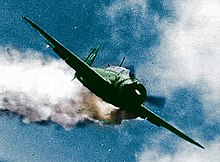Yokosuka D4Y
| Yokosuka D4Y Suisei | |
|---|---|
 A Yokosuka D4Y3 Type 33 “Suisei” in flight |
|
| Type: | Dive bombers |
| Design country: | |
| Manufacturer: | |
| First flight: |
December 1940 |
| Commissioning: |
1942 |
| Production time: |
1942 to 1945 |
| Number of pieces: |
2,038 |

The Yokosuka D4Y Suisei ( Japanese 彗星 , "Comet", allied code name "Judy") was a dive bomber of the Imperial Japanese Navy during World War II .
history
It was developed by the First Naval Aviation Technical Arsenal in Yokosuka on the basis of two Heinkel He 118s that were delivered from Germany . The first prototype of the D4Y1 made a maiden flight in December 1940. The easy-to-use aircraft performed very well. However, when the successful trial program accelerated, there was the first unpleasant surprise. Despite the well-structured and functional appearance, there were weaknesses in the structure of the wings. When attempting a dive, the wings began to vibrate, sometimes so much that the wing spars threatened to break. For a dive bomber this was of course an unacceptable property, so the first models were used as reconnaissance aircraft from 1942 onwards . Two aircraft of this type were carried in the Battle of Midway , one of which was used.
By March 1943, the structural problems could be resolved and series production of a total of 2,038 aircraft began. Most of the suisei were built by Aichi .
The first versions of the Yokosuka D4Y Suisei could only be kept ready for use with a great deal of technical effort, since the liquid-cooled Atsuta V - 12-cylinder - aircraft engines with hanging cylinders, which were a license production of the German Daimler-Benz DB 601 , were unreliable in contrast to this and were difficult to maintain. Already at the beginning of the development there were voices calling for the installation of an air-cooled radial engine , the type of engine common in Japan.
As soon as the permit was obtained, the Aichi design team began to look for a suitable radial engine. The final choice was the 14-cylinder Mitsubishi MK8P Kinsei-62 double radial engine with an output of 1,163 kW (1,560 hp), which now powered the Yokosuka D4Y3 Model 33. The disadvantage of the radial engine was that the pilot's view forwards and downwards was impaired, which meant that it was no longer possible to use this variant on an aircraft carrier .
The D4Y was extremely fast for a dive bomber. Therefore, some were converted to night fighters for use against the US Boeing B-29 . At the 11th Naval Aviation Arsenal in Hiro, an attempt was made to develop a D4Y2-S night fighter by removing all bomb equipment and placing a 20 mm Type 99 Model 2 cannon at the gunner's position as upward-firing " weird music ". However, the lack of a radar system and low rate of climb made these night fighters ineffective.
In the absence of armor and self-sealing tanks, the Suiseis were easy victims for the Allied hunters.
The D4Y operated from the following Japanese aircraft carriers: Chitose , Chiyoda , Hiyō , Junyō , Shin'yō , Shōkaku , Sōryū , Taihō , Unryū , Unyō and Zuikaku . In addition, it was initially planned to use the D4Y on the hybrid aircraft carriers of the Ise class .
The last version to be built was the D4Y4 special attack bomber Model 43. This single-seat kamikaze aircraft, built from February 1945, could carry an 800 kg bomb. It was equipped with three start-up rockets for launching short runways and for the final dive acceleration.
Technical specifications
| Parameter | Data (D4Y2) |
|---|---|
| crew | 2 (pilot and gunner / radio operator) |
| length | 10.22 m |
| span | 11.50 m |
| height | 3.74 m |
| Wing area | 23.60 m² |
| Empty mass | 2,440 kg |
| Takeoff mass | maximum 4,250 kg |
| Engine | an Aichi Atsuta AEIA 32 with 1,044 kW (approx. 1,420 PS) |
| Top speed | 550 km / h at an altitude of 4,750 m |
| Range | 1,465 km |
| Summit height | 10,700 m |
| Wing loading | 180 kg / m² |
| Power / weight ratio | 0.25 kW / kg |
| Armament | two forward-firing 7.7 mm machine guns one backward-firing 7.92 mm machine gun up to 800 kg bombs |
photos
literature
- Chris Bishop: Weapons of World War II. An encyclopedia. ISBN 3-8289-5385-9 , p. 396.
Web links
Footnotes
- ↑ For the Ise aircraft, see: Michel Ledet: Samourai sur Porte-Avions. Outreau 2006, a very detailed and comprehensively illustrated representation of the Japanese carrier aircraft from 1922 to 1945, based on the latest research in marine history. Admiral Matsuda Chiaki himself reported the details of the aircraft group and the training as well as the operations of the Ise up to the beginning of 1945, in: Interrogation Nav No. 69 in USSBS No. 345 of November 12, 1945. For identification and endowment also: Eduardo Cea: The Air Force of the Japanese Imperial Navy - Carrier Based Aircraft 1922-1945. Part II, pp. 45-48. Basic information on the naval aircraft of the Japanese 1941-1945 can be found in the generally accepted standard reference book by: René J. Francillon: Japanese Aircraft of the Pacific War. 2nd edition, London 1979/1994.




